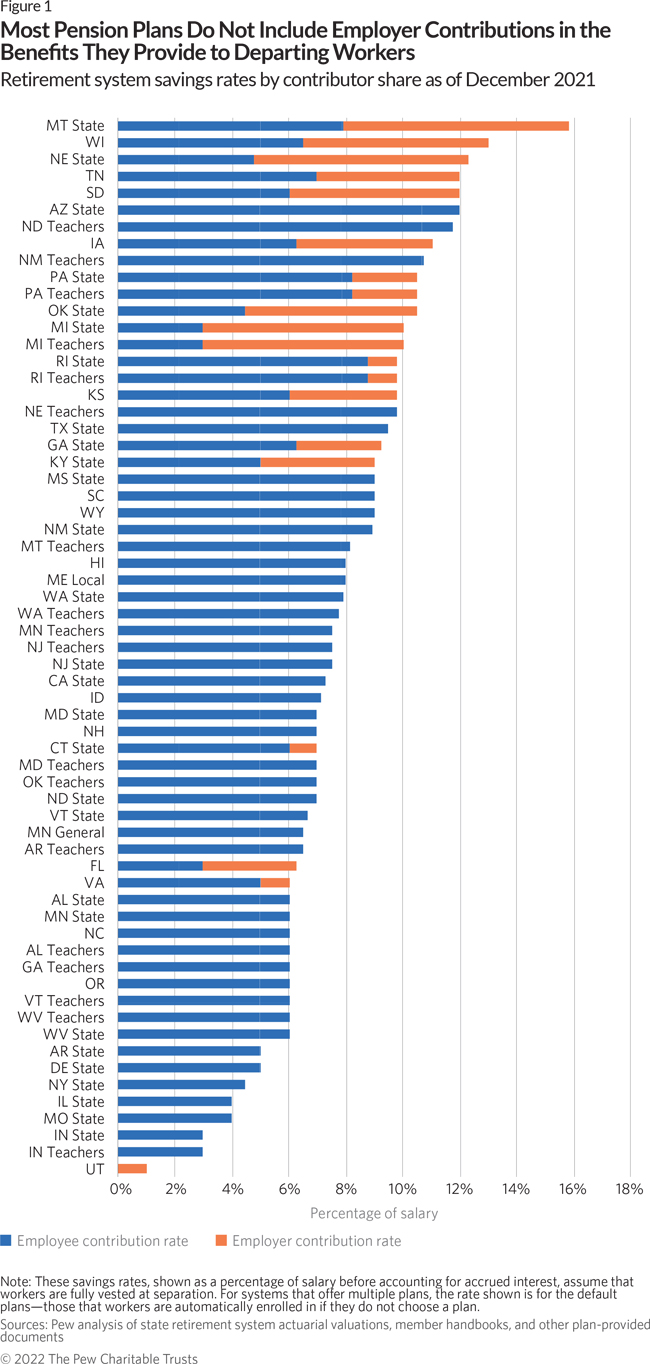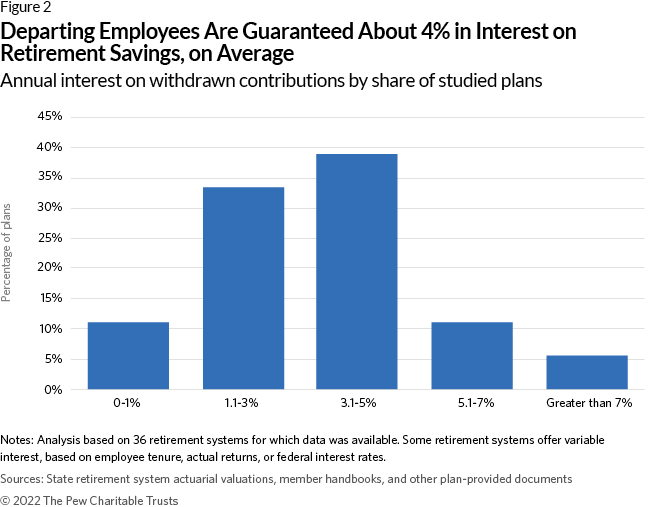Savings Rate Fills Out Picture of Workers' Retirement Security
Only a handful of state public pension systems deliver recommended benefit levels for employees who leave

Overview
States generally provide robust retirement benefits to their career workers, those who spend most or all of their careers employed in the public sector. But what can workers, especially younger employees in the early or middle years of their careers, expect from their pension plans if they leave state or local employment before reaching retirement eligibility?
When evaluating the strength of retirement fund benefits, analysts often refer to the replacement rate, which assesses how much income career workers can expect in retirement as a share of the take-home pay they received in their final year of employment.1 However, although the replacement rate provides important insight about career workers’ ability to maintain their standard of living in retirement, it does not capture how well plans support workers who change jobs before retirement. In particular, it doesn’t measure whether and to what extent retirement plans allow departing workers to take benefits with them.
To assess the retirement security of these employees, The Pew Charitable Trusts conducted an analysis using another metric: the retirement savings rate. This measure calculates how much money, expressed as a percentage of annual salary, employees can withdraw from their pension funds when leaving an employer before reaching retirement eligibility. Employees typically have access to their own contributions—the funds taken from their paychecks—to the retirement plan, as well as the compounded interest on those funds. In some cases, they can also withdraw some or all of the employer contributions made on their behalf. The metric provides information about not only departing vested employees, but also unvested workers—those who have not worked long enough to receive full benefits.
In addition, Pew examined expert recommendations and private sector defined contribution (DC) plans—such as 401(k) or other retirement systems that do not guarantee specific benefit levels—to identify reasonable savings benchmarks against which to evaluate the benefits provided by various public sector plans. That review found that average savings levels in individual private sector retirement accounts are generally more than 10% of each worker’s final annual salary; most experts recommend that individuals save at least 12% to 15%, depending on age and other factors, of their annual salary for retirement.2
With these benchmarks in mind, Pew then analyzed outcomes for workers who leave early- or mid-career from jobs covered by the 81 state and teacher retirement systems across the country. The researchers then narrowed their focus to the 63 systems whose members participate in Social Security, and found that:
- Only five state systems—in Montana, Nebraska, South Dakota, Tennessee, and Wisconsin—provided a savings rate of at least 12%. These plan officials intentionally structured their systems, which include a range of defined benefit (DB) and hybrid plan designs, to ensure that separating employees would have access to benefits that include employer contributions in addition to their own contributions.
- Only 14 systems achieved a savings rate of 10% or above.
- The average savings rate was 8%—and nearly a third had a rate of 6% or less.
- Access to employer contributions plays a key role in pushing savings rates above the 10% or 12% benchmarks. Eleven of 14 systems with a savings rate of at least 10% provide separating workers with some employer contributions, compared with only nine of the 49 systems with savings rates below 10%.
- Separating workers also withdraw the interest credited to the contributions, with interest rates ranging from about 1% to 8% and averaging roughly 4%.
To provide a picture of retirement security across the public sector workforce, this research builds on a 2020 Pew study, “How Measuring Replacement Income Can Aid Assessment of Public Pension Plans,” which looked at state retirement systems’ replacement rates and found that, in general, career workers can expect the benefits
from their pension plans to match their final take-home pay in retirement. Taken together, the findings from these analyses reinforce that no one design serves all states. In particular, the five systems shown in this latest research to deliver savings rates of 12% or more use different models to achieve strong benefits for career workers and departing employees alike.3
Yet even given their varied designs, those five systems also share important features to enhance retirement security, such as supplemental account options to boost retirement savings and innovative and targeted retirement education. This brief delves into how systems across the nation differ in terms of supporting workers’ retirement security and explores the characteristics of the most effective plans.
Savings Rate Is a Key Metric for Certain Workers
The savings rate is an important metric for two groups of state employees: people who leave a job before vesting and vested workers who leave a job many years before becoming eligible for retirement.
The former group is not eligible for a pension; taking their contributions, plus interest, is these workers’ only option at separation. The savings rate is the best metric for capturing their benefit level because it shows how much money they can take with them when they leave the job.
Workers in the latter group are usually eligible for a pension when they retire if they left their money in the retirement system after leaving their jobs. However, those benefits— based on the employee’s final salary in the job—typically lose value over time because they are not generally adjusted for any inflation that occurs after the employee leaves the job. Consequently, withdrawing their money from the retirement system upon leaving a job may be a better financial decision for employees than leaving it in the system until they reach retirement age. This is particularly true for workers who start their public sector careers in their 20s or early 30s, stay at least five years, and leave before achieving 15 to 20 years of service.4 (See Appendix C for more details on vested departing workers.)
Pew’s analysis assumes that separating employees who withdraw their accounts roll them over into a new retirement plan, but evidence from the private sector suggests that some of these workers take at least part of their retirement account in cash and do not invest it into a new plan.5
Less than a quarter of retirement systems give departing workers a savings rate of 10% or more
Only 14 of the systems studied provided a savings rate of at least 10%—and only five offered a rate of at least 12%. (See Appendix B for data on systems whose members do not participate in Social Security.) The average savings rate across the 63 examined systems was 8%, and about a third had a rate of 6% or less. (See Figure 1.)
The default employee contributions in two systems—Virginia and Oklahoma—were too low for an employee to take advantage of the full employer match. In these cases, the analysis used the plan’s default savings rate.
Under Virginia’s hybrid plan, the default savings rate was 6%, but the rate increased to 12.5% for employees who contributed the amount needed to trigger the full employer match. Under Oklahoma’s defined contribution plan, the default savings rate was 10.5%, but jumped to 14% for employees who contributed enough to get the full match.
The five states with the highest savings rates—Montana, Nebraska, South Dakota, Tennessee, and Wisconsin— provide savings rates of at least 12% while ensuring that career workers retire with a full replacement rate.
Although these systems use a range of innovative plan designs, they all guarantee that departing workers can take some or all of the employer contributions and provide instructive examples of how states can design their plans to meet retirement security goals across the workforce:
- Montana and Wisconsin both ensure that worker benefits include employer contributions by providing two different benefit calculations: Workers receive the greater of a traditional pension formula or a “money purchase” benefit, which calculates an annuity using accumulated employee contributions matched by employer contributions plus interest. The former typically works best for career employees while the latter tends to better serve other workers, such as employees who leave mid-career.
- The South Dakota Retirement System (SDRS) is one of the few systems in the country that uses an inflation indexing provision to guarantee that workers who separate early or mid-career receive a meaningful benefit. The system applies an annual cost of living adjustment to departed workers’ final salaries so that their benefits are not eroded by inflation.6 In addition, workers who choose to withdraw their account at separation also have access to at least some of the employer contributions. SDRS also uses innovative strategies to increase participation in the state’s supplemental savings account systems, including auto- enrollment for some plan members.
- Tennessee’s hybrid plan combines defined benefit and defined contribution elements to deliver a high replacement rate to career workers and a savings rate of 12% for those who leave before retirement. The use of individual savings accounts enables separating workers to take employer contributions with them. In addition, the state’s retirement system helps plan participants prepare for retirement by offering comprehensive education, including an online tool to predict retirement replacement rate, one-on-one financial counseling, and targeted outreach to workers with insufficient savings levels.7
- Nebraska employs another type of hybrid plan—cash balance—in which workers receive individual retirement accounts with a guaranteed minimum annual investment return. Under this plan, employees have access to employer contributions and have the option upon retirement to convert their accounts into guaranteed lifetime income payments at a set annuity rate (7.3% as of 2022).
Several features of these systems point to areas for future research, including the role that supplemental savings accounts play in state and local worker retirement security as well as the different ways that systems approach retirement readiness education and counseling.
Employer-provided interest varies between systems
In addition to employee and employer contributions, separating workers also receive the employer-provided interest credited to their accounts. A plan’s interest rate can be fixed from year to year, or it can vary annually based on pension board recommendations, Treasury bond yield rates, or an employee’s years of service. And different systems provide employees various interest rates, ranging from zero to 8%. (See Figure 2.) The average is a little less than 4%, with most systems providing a rate between 2% and 5%.8
Conclusion
Although no universal standard exists by which to measure retirement security, this analysis shows that using the retirement savings rate in addition to the replacement rate can provide a picture of workers’ financial preparedness across the workforce. And when states’ public sector retirement systems are viewed through this more complete lens, only five meet key benchmarks for the strength of their benefits, particularly in providing both full replacement rates for career workers and ensuring that separating workers can retain some or all of the employer contributions made on their behalf.
Each of these top-performing systems uses a defined benefit or hybrid plan designed to meet retirement security goals and includes features such as access to supplemental defined contribution accounts and retirement planning and financial education programs. Together with Pew’s previous research, this analysis shows that states can embrace a range of models to achieve strong results that provide retirement security for all public sector workers who leave or change jobs.
Appendix A: Methodology
Pew looked at the savings rate for 81 public sector retirement systems, incorporating each state’s primary plan for general state workers and teachers and other school employees. In most cases, these plans do not cover public safety employees, judges, or legislators. Of the systems studied, 63 participate in Social Security and are the primary focus of the analysis; the data on the other 18 systems can be found in Appendix B.
For each retirement system, Pew calculated the savings rate for new plan members. In addition, for the nine state systems offering workers the choice between a plan with a DB component—either a standard DB plan or hybrid plan—and a DC plan, Pew based its analysis on the default plan. 9
Additionally, in some systems, contributions vary from year to year based on actuarially determined contribution rates. In particular, employee contributions to the Arizona State Retirement System vary each year, as do employer contributions to the Utah Public Employees Contributory Retirement System’s hybrid plan. For these state plans, Pew used contribution rates as of 2021, the most recent available.
Although nearly all public sector workers have the choice to also participate in defined contribution accounts as a supplement to their DB plans, Pew did not include these accounts in its analysis because participation is optional and the level of employee contributions is typically low.10
Appendix B: Savings rate tables
Table B.1
Savings Rates for Retirement Systems That Participate in Social Security, by State
| State | Plan name | Employee contribution | Employer contribution | Total savings rate |
|---|---|---|---|---|
| Montana | Public Employees' Retirement System | 7.90% | 7.90% | 15.80% |
| Wisconsin | Wisconsin Retirement System | 6.50% | 6.50% | 13.00% |
| Nebraska | State Employees' Retirement System | 4.80% | 7.49% | 12.29% |
| Tennessee | Tennessee Consolidated Retirement System | 7.00% | 5.00% | 12.00% |
| South Dakota | South Dakota Retirement System | 6.00% | 6.00% | 12.00% |
| Arizona | Arizona State Retirement System | 11.94% | 0.00% | 11.94% |
| North Dakota | Teachers' Fund for Retirement | 11.75% | 0.00% | 11.75% |
| Iowa | Public Employees' Retirement System | 6.29% | 4.72% | 11.01% |
| New Mexico | Educational Employees' Retirement System | 10.70% | 0.00% | 10.70% |
| Pennsylvania | State Employees' Retirement System | 8.25% | 2.25% | 10.50% |
| Pennsylvania | Public School Employees' Retirement System | 8.25% | 2.25% | 10.50% |
| Oklahoma | Public Employees Retirement System | 4.50% | 6.00% | 10.50% |
| Michigan | State Employees’ Retirement System | 3.00% | 7.00% | 10.00% |
| Michigan | Public School Employees’ Retirement System | 3.00% | 7.00% | 10.00% |
| Rhode Island | Employees' Retirement System— State Employees | 8.75% | 1.07% | 9.82% |
| Rhode Island | Employees' Retirement System—Teachers | 8.75% | 1.07% | 9.82% |
| Kansas | Public Employees Retirement System | 6.00% | 3.81% | 9.81% |
| Nebraska | School Retirement System | 9.78% | 0.00% | 9.78% |
| Texas | Employees Retirement System | 9.50% | 0.00% | 9.50% |
| Georgia | Employees' Retirement System | 6.25% | 3.00% | 9.25% |
| Kentucky | Employees Retirement System— Nonhazardous | 5.00% | 4.00% | 9.00% |
| Mississippi | Public Employees' Retirement System | 9.00% | 0.00% | 9.00% |
| South Carolina | South Carolina Retirement System | 9.00% | 0.00% | 9.00% |
| Wyoming | Public Employees Pension Plan | 9.00% | 0.00% | 9.00% |
| New Mexico | Public Employees Retirement System | 8.92% | 0.00% | 8.92% |
| Montana | Teachers' Retirement System | 8.15% | 0.00% | 8.15% |
| Hawaii | Employees' Retirement System | 8.00% | 0.00% | 8.00% |
| Maine | Participating Local Districts Program | 8.00% | 0.00% | 8.00% |
| Washington | Public Employees' Retirement System— Plans 2 & 3 | 7.90% | 0.00% | 7.90% |
| Washington | Teachers' Retirement System—Plans 2 & 3 | 7.77% | 0.00% | 7.77% |
| Minnesota | Teachers Retirement Fund | 7.50% | 0.00% | 7.50% |
| New Jersey | Teachers' Pension and Annuity Fund | 7.50% | 0.00% | 7.50% |
| New Jersey | Public Employees' Retirement System | 7.50% | 0.00% | 7.50% |
| California | Public Employees' Retirement Fund | 7.25% | 0.00% | 7.25% |
| Idaho | Public Employee Retirement System of Idaho (PERSI) Base Plan | 7.16% | 0.00% | 7.16% |
| Maryland | Employees' Retirement and Pension System | 7.00% | 0.00% | 7.00% |
| New Hampshire | New Hampshire Retirement System | 7.00% | 0.00% | 7.00% |
| Connecticut | State Employees' Retirement System | 6.00% | 1.00% | 7.00% |
| Maryland | Teachers' Retirement and Pension System | 7.00% | 0.00% | 7.00% |
| Oklahoma | Teachers' Retirement System | 7.00% | 0.00% | 7.00% |
| North Dakota | Public Employees' Retirement System | 7.00% | 0.00% | 7.00% |
| Vermont | State Retirement System | 6.65% | 0.00% | 6.65% |
| Minnesota | General Employees Retirement Fund | 6.50% | 0.00% | 6.50% |
| Arkansas | Teacher Retirement System | 6.50% | 0.00% | 6.50% |
| Florida | Florida Retirement System | 3.00% | 3.30% | 6.30% |
| Virginia | Virginia Retirement System | 5.00% | 1.00% | 6.00% |
| Alabama | Employees' Retirement System | 6.00% | 0.00% | 6.00% |
| Minnesota | State Employees Retirement Fund | 6.00% | 0.00% | 6.00% |
| North Carolina | Teachers' and State Employees' Retirement System | 6.00% | 0.00% | 6.00% |
| Alabama | Teachers' Retirement System | 6.00% | 0.00% | 6.00% |
| Georgia | Teachers Retirement System | 6.00% | 0.00% | 6.00% |
| Oregon | Public Employees Retirement System | 6.00% | 0.00% | 6.00% |
| Vermont | State Teachers’ Retirement System | 6.00% | 0.00% | 6.00% |
| West Virginia | Teachers’ Retirement System | 6.00% | 0.00% | 6.00% |
| West Virginia | The Public Employees’ Retirement System | 6.00% | 0.00% | 6.00% |
| Arkansas | Public Employees Retirement System | 5.00% | 0.00% | 5.00% |
| Delaware | State Employees' Pension Plan | 5.00% | 0.00% | 5.00% |
| New York | Employees' Retirement System | 4.50% | 0.00% | 4.50% |
| Illinois | State Employee Retirement System | 4.00% | 0.00% | 4.00% |
| Missouri | State Employees' Plan | 4.00% | 0.00% | 4.00% |
| Indiana | Public Employee Retirement Fund | 3.00% | 0.00% | 3.00% |
| Indiana | State Teachers' Retirement Fund | 3.00% | 0.00% | 3.00% |
| Utah | Utah Public Employees Contributory Retirement System | 0.00% | 1.05% | 1.05% |
Notes: For states that give plan members the choice between two plans, the table shows the savings rate for the default plan. In addition, the savings rates shown are based on default employee contribution rates even if those rates are not sufficient to trigger the full employer match.
Sources: Pew analysis of state retirement system actuarial valuations, member handbooks, and other plan-provided documents
© 2022 The Pew Charitable Trusts
Table B.2
Savings Rates for Retirement Systems That Do Not Participate in Social Security, by State
| State | Plan name | Employee contribution | Employer contribution | Total savings rate |
|---|---|---|---|---|
| Alaska | Teachers' Retirement System | 8.00% | 7.00% | 15.00% |
| Alaska | Public Employees' Retirement System | 8.00% | 5.00% | 13.00% |
| California | State Teachers' Retirement Fund | 10.20% | 0.00% | 10.20% |
| Colorado | State Division Trust Fund | 8.75% | 8.80% | 17.55% |
| Colorado | School Division Trust Fund | 8.80% | 0.00% | 8.80% |
| Connecticut | Teachers' Retirement System | 7.00% | 0.00% | 7.00% |
| Illinois | Teachers' Retirement System | 8.00% | 0.00% | 8.00% |
| Kentucky | Teachers' Retirement System | 12.90% | 0.00% | 12.90% |
| Louisiana | State Employees' Retirement System | 8.00% | 0.00% | 8.00% |
| Louisiana | Teachers' Retirement System of Louisiana | 8.00% | 0.00% | 8.00% |
| Maine | State Employee and Teacher Program | 7.70% | 0.00% | 7.70% |
| Massachusetts | Teachers' Retirement System | 11.00% | 0.00% | 11.00% |
| Massachusetts | State Employees' Retirement System | 9.00% | 0.00% | 9.00% |
| Missouri | Public School Retirement System | 14.50% | 0.00% | 14.50% |
| Nevada | Public Employees' Retirement System | 14.50% | 0.00% | 14.50% |
| Ohio | Public Employees Retirement System | 10.00% | 0.00% | 10.00% |
| Ohio | State Teachers Retirement System | 14.00% | 0.00% | 14.00% |
| Texas | Teacher Retirement System | 7.70% | 0.00% | 7.70% |
Note: For states that give plan members the choice between two plans, the table shows the savings rate for the default plan.
Sources: Pew analysis of state retirement system actuarial valuations, member handbooks, and other plan-provided documents
© 2022 The Pew Charitable Trusts
Appendix C: Benefit comparisons based on years of service
To determine whether vested workers in a given state were better off withdrawing their contributions at separation versus leaving them in the retirement systems, Pew calculated a hypothetical worker’s benefits under a defined benefit plan with a 1.8% multiplier at a range of start and withdrawal ages and under a defined contribution plan with a 10% savings rate.11
The results show that, on average, vested workers who leave a job by age 45 would receive a higher benefit under a 10% savings rate DC plan than under a DB plan with a 1.8% multiplier. Using withdrawal data from representative state plans, Pew determined that about 40% of workers fall into that category. For example, a hypothetical worker who starts a public sector job at age 25 and leaves at 35 could expect a 7% replacement rate under a defined benefit plan with a 1.8% multiplier but a 12% replacement rate under a defined contribution plan with a 10% savings rate—a 71% difference. If the same worker leaves at age 45, the defined benefit replacement rate increases to 19%, but the defined contribution replacement rate remains 16% higher at 22%. However, if this worker leaves at age 65, the defined benefit replacement rate jumps to 68%, well above the defined contribution replacement rate of 37%. (See Table C.1.)
Table C.1
Plan Assumptions
| Example DB plan | Example DC plan | |
|---|---|---|
| Multiplier | 1.8% | n/a |
| Number of years used to calculate final average salary | 5 | n/a |
| Total DC contributions | n/a | 10% |
| DC annuity rate | n/a | 3.0% |
| DC interest rate | n/a | 5.0% |
| Payroll growth rate | 3.0% | 3.0% |
| Starting salary | $27,453 | $27,453 |
| Expected number of years in retirement | 23 | 23 |
Endnotes
- The Pew Charitable Trusts, “How Measuring Replacement Income Can Aid Assessment of Public Pension Plans” (2020), https://www.pewtrusts.org/-/media/assets/2021/01/how_measuring_replacement_income.pdf.
- The 10% benchmark is based on the private sector, where workers who have access to an employer-sponsored retirement plan typically save about 10% to 11% of their salaries annually. Vanguard, “How America Saves” (2021), https://institutional.vanguard.com/content/dam/inst/vanguard-has/insights-pdfs/21_CIR_HAS21_HAS_FSreport.pdf. The 12% benchmark is based on expert recommendations, including one of the most widely cited studies on the topic, from the RETIRE Project at Georgia State University, which estimated that plans should target a replacement rate of more than 70% for most workers. Subsequent research calculated a savings rate of at least 12% needed to meet that goal, and other studies provide similar recommendations. See M. Morrissey, “The State of American Retirement Savings” (Economic Policy Institute, 2019), https://files.epi.org/pdf/136219.pdf; R. Crane, M. Heller, and P. Yakoboski, “Defined Contribution Pension Plans in the Public Sector: A Best Practice Benchmark Analysis” (TIAA-CREF Institute, 2008), https:// www.tiaainstitute.org/sites/default/files/presentations/2017-02/DCPlansinPublicSectorCraneHellerandYako.pdf; J. Brown, “Millennials and Retirement: Already Falling Short” (National Institute on Retirement Security, 2018), https://www.nirsonline.org/wp-content/uploads/2018/02/Millennials-Report-1.pdf.
- See The Pew Charitable Trusts, “Measuring Replacement Income”; The Pew Charitable Trusts, “Metrics for Measuring Public Employee Retirement Security” (2020), https://www.pewtrusts.org/en/research-and-analysis/fact-sheets/2020/01/metrics-for-measuring- public-employee-retirement-security.
- Employees who separate from a public employer and move to a different state or local retirement system may have the option of purchasing additional years to apply toward their retirement benefits under the new system.
- J. VanDerhei, “The Impact of Auto Portability on Preserving Retirement Savings Currently Lost to 401(k) Cashout Leakage” (EBRI, 2019), https://www.ebri.org/content/the-impact-of-auto-portability-on-preserving-retirement-savings-currently-lost-to-401(k)-cashout-leakage.
- For more information on the South Dakota Retirement System’s inflation protection feature, see South Dakota Retirement System, “Class A Handbook” (2021), https://sdrs.sd.gov/docs/ClassAGenerationalMemberHandbook.pdf.
- Tennessee Department of Treasury, “Discover RetireReadyTN!,” accessed Feb. 14, 2022, https://treasury.tn.gov/Retirement/Retire-Ready-Tennessee/Discover-RetireReadyTN.
- The interest rate used for each plan is based on the most recent assumptions available. For plans with varying annual interest rates, Pew calculated the average interest rate for the past 10 to 15 years, depending on data availability.
- In most cases, the savings rates for the default and alternative plans are very similar. However, they differ substantially in a few instances. In particular, the North Dakota Public Employees Retirement System’s and South Carolina Retirement’s defined contribution plans have savings rates that meet the 12% benchmark, but the default defined benefit option does not.
- M. Petersen and J. VanDerhei, “The State of Public Sector DC Plans: A First Look at the PRRL Database” (Public Retirement Research Lab, 2021), https://www.nagdca.org/wp-content/uploads/2021/02/PRRL-Study_The-State-of-DC-Plans_A-First-Look_FINAL.pdf.
- The average multiplier, nationally, is 1.8% and is within plus or minus 0.2 percentage points of the multiplier for most defined benefit plans that participate in Social Security.


America’s Overdose Crisis
Sign up for our five-email course explaining the overdose crisis in America, the state of treatment access, and ways to improve care
Sign up

Measuring Replacement Income Can Help with Pension Plans


Metrics for Measuring Public Employee Retirement Security














